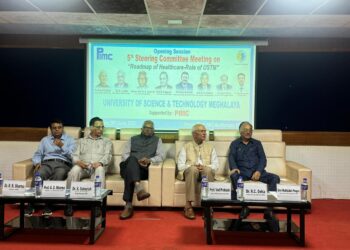GUWAHATI,16th November 2023: Researchers from Indian Institute of Technology Guwahati (IIT Guwahati) and U.R. Rao Satellite Centre, Indian Space Research Organisation (ISRO), Bengaluru, for the first time, have detected polarized emissions from a black hole source that exists beyond our Milky Way Galaxy through a technique called X-ray polarimetry.
Large Magellanic Cloud X-3 (LMC X3) is a binary star system consisting of a black hole and a ‘normal’ star that is much hotter, bigger, and more massive than the Sun. It is located in a satellite galaxy of our Milky Way, nearly 200,000 light-years away from Earth. Since its discovery in 1971, it has been observed by various satellites. However, there has been a gap in understanding the polarization properties of X-rays emitted by highly energetic objects like stellar mass black holes in the universe.
Highlighting the importance of this research, Prof Santabrata Das, Department of Physics, IIT Guwahati, said, “X-ray polarimetry is a unique observational technique to identify where radiation comes from near black holes. LMC X-3 emits X-rays that are 10,000 times more powerful than those from the Sun. When these X-rays interact with the material around black holes, specifically when they scatter, it changes the polarization characteristics, i.e. degree and angle. This helps in understanding how matter is drawn toward black holes in the presence of intense gravitational forces.”
The researchers studied LMC X-3 usingThe Imaging X-ray Polarimetry Explorer (IXPE), the first mission of NASA to study the polarization of X-rays from celestial objects. They also made use of the simultaneous broad-band coverage of Neutron Star Interior Composition Explorer (NICER) Mission and Nuclear Spectroscopic Telescope Array (NuSTAR) Mission to constrain the spin of LMC X-3.
Speaking about this novel finding Dr. Anuj Nandi,Scientist,U.R. Rao Satellite Centre (URSC), ISRO, Bangalore, said “Intense gravitational fields can cause the emitted light from black holes to become polarized. Our observations indicate that LMC X-3 likely harbours a black hole with low rotation rate, surrounded by a slim disc structure that gives rise to the polarized emissions. “
The study has been published in the Monthly Notices of the Royal Astronomical Society: Letters and was funded by the Science and Engineering Research Board (SERB), Department of Science and Technology, India. The research team is led by Prof. Santabrata Das from IIT Guwahati and Dr. Anuj Nandi from URSC, Bangalore, and includes their research scholars, Mr. Seshadri Majumder (IIT Guwahati), and Mr. Ankur Kushwaha (URSC).
These findings open a new window to investigate and understand the nature of astrophysical black hole sources.
ABOUT IIT GUWAHATI
Indian Institute of Technology Guwahati, established in 1994, completed 25 years of glorious existence in 2019. At present, the Institute has eleven departments, nine interdisciplinary academic centres and five schools covering all the major engineering, science, healthcare, management, design and humanities disciplines, offering BTech, BDes, BSc(Hons), MA, MDes, MTech, MSc, MS(R), MBA and PhD programmes. The institute offers a serene residential campus to ~450 faculty members and more than 8,600 students at present.
IIT Guwahati has retained the 7th position among the best engineering institutions of the country and 9th position in both ‘Overall’ and ‘Research’ Categories in the ‘India Rankings 2023’ declared by the National Institutional Ranking Framework (NIRF) of the Union Ministry of Education.
IIT Guwahati has achieved rank 6 in the SDG 7 (Affordable and clean energy) globally in the Times Higher Education (THE) Impact Rankings 2023 and is the only academic institution in India that occupied a place among the top 100 world universities – under 50 years of age – ranked by London-based Times Higher Education (THE) in 2014 and continues to maintain its superior position even today in various International Rankings. IIT Guwahati gained rank 32 globally in the ‘Research Citations per Faculty’ category and overall 364 rank in the QS World University Rankings 2024. In the QS Asia University Rankings 2024, the Institute is ranked 111th in overall category.
Among other frontier areas of research and innovation, IIT Guwahati is working towards augmenting critical research, technology and entrepreneurship initiatives in Genomics, Clean energy, Health Care, AI, Bioinformatics and Flexible Electronics, among numerous other areas.









